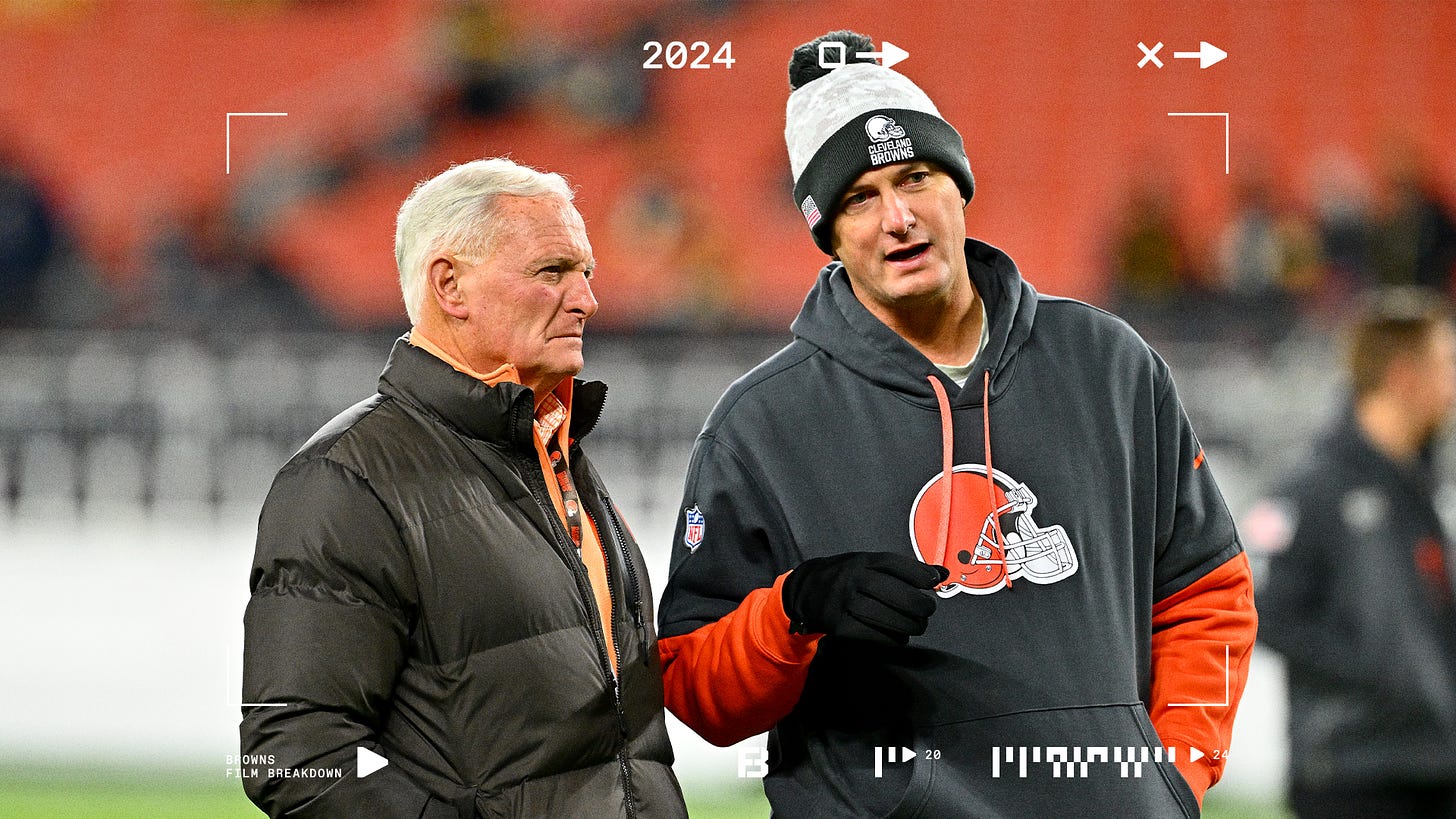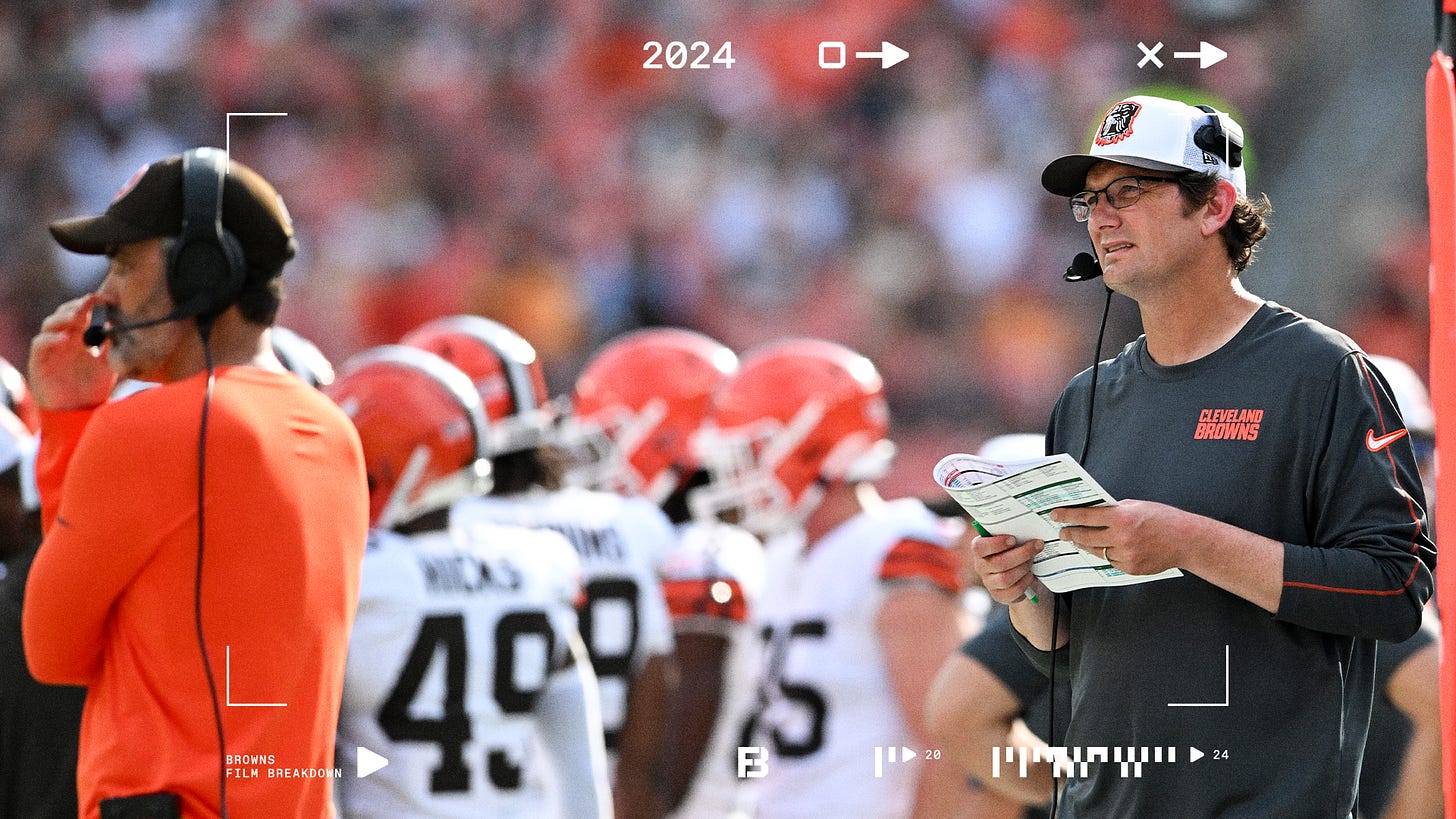How the Browns Offense Fell Apart in 2024
Tracking the inept attempts to improve an offense while missing what mattered most.
As the Browns concluded a dreadful 3-14 season we’ve been left to ponder what happened. How does a team in the midst of a competitive window collapse like this just one year after their heroic perseverance and playoff appearance? We won’t get direct answers but context clues are all around us.
We received the single biggest clue this morning as offensive coordinator Ken Dorsey and offensive line coach Andy Dickerson were swiftly fired the day after their blowout loss in Baltimore. But this one runs deep and solving this sort of deep offense ineptitude takes tracing some steps and laying out decision-making. Here’s what I’ve come to perceive about a set of decisions uprooted just one year into a full staff change.
Let’s rewind the clock to just about a full year ago. The Browns had just finished a miraculous season with a disappointing playoff loss in Houston. The type of unexpected crippling loss that saw their quarterback, resurgent veteran Joe Flacco, throw multiple interceptions returned for touchdowns. It was a reminder of how close they were to relevancy once again but how far away it remained. Rookie C.J. Stroud carved them up that day and they were looking around at an AFC Playoff landscape of Patrick Mahomes, Josh Allen, and Lamar Jackson. Sure, they’re close in a sense, but finding a way to compete with these offenses led by elite signal-callers still felt out of reach.
The playoff loss happened on January 13th and within just a few days the organization made the decision to fire offensive coordinator Alex Van Pelt, running backs coach Stump Mitchell, and not to renew the contract of tight ends coach T.C. McCartney. The decision felt strange given how the offense navigated multiple backup quarterbacks, losing their elite running back, and playing without four different offensive tackles at various points. Players and staff echoed that sentiment behind closed doors.
The offense had finally solved some things. Flacco’s arrival was the perfect example of the type of quarterback Kevin Stefanski meshed with in his best versions of his structure. They paired Flacco’s best traits to what they currently had in place. Sure, the run game had lost its way leaning into horizontal shotgun schemes more than it should, but that can happen when you lose your best player in the attack. They were searching. Flacco’s arrival brought on a revised approach to shotgun play-action and the Browns found a way to effectively mirror run and pass again — a topic we’ll revisit shortly.
The decision to uproot the offensive staff felt jarring at the time, but again, you could sense why the decision was made. The Browns wanted to try and make Deshaun Watson as comfortable as they possibly could. It made sense to put him inside a structure that felt “spread” offense with popular wrinkles of run-pass option and more. Again, even though I hate rigid offense labels, it seemed to make sense. But when you step back and process the decision to remove Van Pelt, and then the coaches the organization hired, you can see clearly where all of this doesn’t add up and never did.
Stefanski had fired and hired a defensive coordinator once in his tenure. He was not immune to staff moves, but rewriting the majority of his offensive staff was something we had yet to see. They had crossed the bridge of minor hire/fire choices inside the group but the core remained. Stefanski was hired to be the mastermind of it all. His key selling point upon being selected as the head coach in 2020 was that he brought the NFL’s popular Shanahan/Kubiak offensive system into the fold with a proven track record of effective zone run game and propping up a quarterback within it’s structure. He was adamant upon hire that his system was ideal for the Browns because of it’s ability to feature Nick Chubb, manipulate defenses with heavy personnel groupings that gave them advantages, and marry the run and pass on any given down to keep defenses guessing.
The concept worked well in 2020 and for the larger parts of 2021 as well. Sure the season didn’t go as planned overall but the offense still had an identity and they leaned into who they were. Then everything changed. They made a choice to part ways with Baker Mayfield and do whatever it took to trade for, and sign, Deshaun Watson. Wherever blame lands for who made the heaviest push for Watson remains a mystery but the clues we are receiving along the way are painting a picture.
As Watson’s suspension was extended deep into 2022, it meant Stefanski and Van Pelt could navigate the offense as it was for the first 11 games and adjust course when necessary. With Jacoby Brissett running the show, the offense operated as they had in previous seasons. They had the 5th best offense by EPA in those 11 games and continued the approach used through their tenure up to that point — zone and gap concepts in the run game, play-action downfield throws off those schemes, and an identity that made sense for the collective.
Then in Week 13, upon Watson’s return to football, they ripped off the band-aid and tried to go full change. Up to that point in the season the Browns had run six RPO concepts. That’s 11 games of offense. Just six. In Week 13 alone with Watson they ran five. And they were an abject disaster. Too fast, too soon.
Keep reading with a 7-day free trial
Subscribe to Browns Film Breakdown to keep reading this post and get 7 days of free access to the full post archives.






